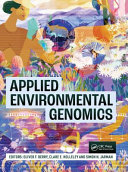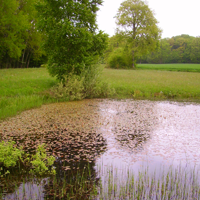
2024
[40] Alp M., Arnaud F., Barthélémy C., Bernez I., Clemens A., Cottet M., Dufour S., Germaine M-A., Gramaglia C., Grivel S. Lepichon C., Lespez L., Lusson M., Navratil O., Piégay H., Prunier J.G., Rollet A-J., Tales E., Lamouroux N. (2024). Restaurer la continuité écologique des cours d’eau : que sait-on et comment passer collectivement à l’action ? VertigO - la revue électronique en sciences de l'environnement http://journals.openedition.org/vertigo/46093 (DOI:10.4000/12ppa)
[39] Fargeot L., Poesy C., Lefort M., Prunier J.G., Krick M., Verdonck R., Veyssière C., Richard M., Legrand D., Loot G., Blanchet S. (2024). Genetic diversity affects ecosystem functions across trophic levels as much as species diversity, but in an opposite direction. eLife 13:RP100041 (DOI:10.7554/eLife.100041.1)
2023
[38] Prunier J.G., Chevalier M., Raffard A., Loot G., Poulet N., Blanchet S. (2023). Genetic erosion reduces biomass temporal stability in wild fish populations. Nature Communication 14, 4362 (DOI:10.1038/s41467-023-40104-4)
[37] Prunier J.G., Veyssière C., Loot G., Blanchet S. (2023). Comparing the utility of microsatellites and single nucleotide polymorphisms in conservation genetics: insights from a study on two freshwater fish species in France. Special issue in Diversity 15(5), 681 (DOI:10.3390/d15050681)
[36] Fargeot L., Poesy C., Lefort M., Prunier J.G., Krick M., Veyssière C., Richard M., Mercier C., Sautreuil M., Huberson N., Langford N., Legrand D., Loot G., Blanchet S. (2023). Genomic and species diversity patterns across multiple trophic levels in riverscapes. Oikos (DOI:10.1111/oik.10015)
[35] Prunier J.G., Loot G., Veyssière C., Poulet N., Blanchet S. (2023). Novel operational index reveals rapid recovery of genetic connectivity in freshwater fish species after riverine restoration. Conservation Letters 16(2), e12939 (DOI:10.1111/conl.12939)
2022
[34] Remon J., Moulherat S., Cornuau J.H., Gendron L., Richard M., Baguette M., Prunier J.G. (2022). Patterns of gene flow across multiple anthropogenic infrastructures: Insights from a multi-species approach. Landscape and Urban Planning 226, 104507 (DOI:10.1016/j.landurbplan.2022.104507)
[33] Prunier J.G.*, Saint-Pé K.*, Tissot L., Poulet N., Marselli G., Veyssière C., Blanchet S. (2022). Captive-bred ancestry affects spatial patterns of genetic diversity and differentiation in brown trout (Salmo trutta) populations. Aquatic Conservation: Marine and Freshwater Ecosystems 32(9), 1529-1543 (DOI:10.1002/aqc.3826; * Shared co-first authorship)
2021
[32] Prunier J.G., Saint-Pé K., Blanchet S., Loot G., Rey O. (2021). Molecular approaches reveal weak sibship aggregation and a high dispersal propensity in a non-native fish parasite. Ecology and Evolution 11(11), 6080-6090 (DOI:10.1002/ece3.7415)
[31] Legrand D., Baguette M., Prunier J.G., Dubois Q., Turlure C., Schtickzelle N. (2021). Congruent Genetic and Demographic Dispersal Rates in a Natural Metapopulation at Equilibrium. Special issue in Genes 12, 362 (DOI:10.3390/genes12030362)
[30] Fargeot L., Loot G., Prunier J.G., Rey O., Veyssière C., Blanchet S. (2021). Patterns of epigenetic diversity in two sympatric fish species: genetic vs. environmental determinants. Special issue in Genes 12, 107 (DOI:10.3390/genes12010107)
[29] De Kort H., Prunier J.G., Ducatez S., Honnay O., Baguette M., Stevens V.M., Blanchet S. (2021). Life history, climate and biogeography interactively affect genetic diversity of plant and animal populations across the globe. Nature Communication 12:516 (DOI:10.1038/s41467-021-20958-2)
[28] Cayuela H., Prunier J.G., Laporte M., Gippet J., Boualit L., Preiss F., Laurent A., Foletti F., Jacob G. (2021). Demography, genetic, and decline of a spatially structured population of lekking bird. Oecologia 195(1), 117-129 (DOI:10.1007/s00442-020-04808-4)
2020
[27] Prunier J.G., Poesy C., Dubut V., Veyssière C., Loot G., Poulet N., Blanchet S. (2020). Quantifying the individual impact of artificial barriers in freshwaters: A standardized and absolute genetic index of fragmentation. Evolutionary Applications 13(10), 2566-2581 (DOI:10.1111/eva.13044)
[26] Blanchet S.*, Prunier J.G.*, Paz-Vinas I.*, Saint-Pé K., Rey O., Raffard A., Mathieu-Bégné E., Loot G., Fourtune L., Dubut V. (2020). A river runs through it: The causes, consequences and management of intraspecific diversity in river networks. Special issue in Evolutionary Applications 13(6), 1195-1213 (DOI:10.1111/eva.12941; * Shared co-first authorship)
2019
[25] Rey O., Eizaguirre C., Angers B., Baltazar-Soares M., Sagonas K., Prunier J.G., Blanchet S. (2019). Linking epigenetics and biological conservation: Towards a conservation epigenetics perspective. Special issue in Functional Ecology 34(2), 414-427 (DOI:10.1111/1365-2435.13429)
[24] Le Chevalier H., Marí-Mena N., Belén C., Prunier J.G., Bossu C., Darnet E., Souchet J., Guillaume O., Calvez O., Bertrand R., Barthe L., Pottier G., Martínez-Sylvestre A., Verdaguer-Foz I., Mossoll-Torres M., Trochet A., Aubret F. (2019). Isolation and characterization of fourteen polymorphic microsatellite markers in the viperine snake Natrix maura. Ecology and Evolution 9(19), 11227-11231 (DOI:10.1002/ece3.5623)
[23] Cayuela H., Boualit L., Laporte M., Prunier J.G., Preiss F., Laurent A.,Foletti F., Clobert J., Jacob, G. (2019). Kin-dependent dispersal influences relatedness and genetic structuring in a lek system. Oecologia 191(1), 97-112 (DOI:10.1007/s00442-019-04484-z)
[22] Raffard A., Cucherousset J., Prunier J.G., Loot G., Santoul F., Blanchet S. (2019). Variability of functional traits and their syndromes in a freshwater fish species ( Phoxinus phoxinus ): The role of adaptive and nonadaptive processes. Ecology and Evolution (DOI:10.1002/ece3.4961)
[21] Dellicour S., Prunier J.G., Piry S., Eloy M.-C., Bertouille S., Licoppe A., Frantz A.C., Flamand M.-C. (2019). Landscape genetic analyses of Cervus elaphus and Sus scrofa: comparative study and analytical developments. Heredity 123, 228–241(DOI:10.1038/s41437-019-0183-5)
2018
[20] Jacob S., Laurent E., Haegeman B., Bertrand R., Prunier J.G., Legrand D., Cote J., Chaine A.S., Loreau M., Clobert J., Schtickzelle N. (2018). Habitat choice meets thermal specialization: Competition with specialists may drive suboptimal habitat preferences in generalists. Proceedings of the National Academy of Sciences PNAS 115(47), 11988-11993 (DOI:10.1073/pnas.1805574115)
[19] Cayuela H., Rougemont Q., Prunier J.G., Moore J.-S., Clobert J., Besnard A., Bernatchez L. (2018). Demographic and genetic approaches to study dispersal in wild animal populations: A methodological review. Invited review in Molecular Ecology 27(20), 3976–4010 (DOI:10.1111/mec.14848)
[18] Remon J., Chevallier E., Prunier J.G., Baguette M., Moulherat S. (2018). Estimating the permeability of linear infrastructures using recapture data. Landscape Ecology 33(10), 1697-1710 (DOI:10.1007/s10980-018-0694-0)
[17] Saint-Pé, K., Blanchet, S., Tissot, L., Poulet, N., Plasseraud, O., Loot, G., Veyssière, C., Prunier J.G. (2018). Genetic admixture between captive-bred and wild individuals affects patterns of dispersal in a brown trout (Salmo trutta) population. Conservation Genetics 19(5), 1269-1279 (DOI:10.1007/s10592-018-1095-2)
[16] Lobora A.L., Nahonyo C.L., Munishi L.K., Caro T., Foley C., Prunier J.G., Beale C.M. and Eggert L.S. (2018). Incipient signs of genetic differentiation among African elephant populations in fragmenting miombo ecosystems in south-western Tanzania. African Journal of Ecology 56(4), 993-1002 (DOI:10.1111/aje.12534)
[15] De Kort H., Prunier J.G., Tessier M., Turlure C., Baguette M., Stevens V.M. (2018). Interacting grassland species under threat of multiple global change drivers. Journal of Biogeography 45(9), 2133-2145 (DOI:10.1111/jbi.13397)
[14] Prunier J.G., Blanchet S. (2018). Using connectivity to identify climatic drivers of local adaptation: a response to Macdonald et al. Ecology Letters 21(7), 1121-1123 (DOI:10.1111/ele.12972)
[13] De Kort H., Baguette M., Prunier J.G., Tessier M., Monsimet J., Turlure C., Stevens V.M. (2018). Genetic co-structure in a meta-community under threat of habitat fragmentation. Molecular Ecology 27(9), 2193-2203 (DOI:10.1111/mec.14569)
[12] Fourtune L., Prunier J.G., Paz-Vinas I., Loot G., Veyssière C., Blanchet S. (2018). Inferring causalities in landscape genetics: An extension of Wright’s causal modeling to distance matrices. American Naturalist 191(4), 491-508 (DOI: http://dx.doi.org/10.1086/696233 )
[11] Prunier J.G., Dubut V., Loot G., Tudesque L., Blanchet S. (2018). The relative contribution of river network structure and anthropogenic stressors to spatial patterns of genetic diversity in two freshwater fishes: A multiple-stressors approach. Special issue in Freshwater Biology, 63(1), 6–21 (DOI:10.1111/fwb.13034)
2017
[10] Prunier J.G., Dubut V., Chikhi L., Blanchet S. (2017). Contribution of spatial heterogeneity in effective population sizes to the variance in pairwise measures of genetic differentiation. Methods in Ecology and Evolution 8(12), 1866–1877 (DOI: 10.1111/2041-210X.12820)
[9] Blanchet S., Prunier J.G., De Kort H. (2017). Time to Go Bigger: Emerging Patterns in Macrogenetics. Trends in Genetics 33(9), 579–580 (DOI:10.1016/j.tig.2017.06.007)
[8] Dellicour S., Gerard M., Prunier J.G., Dewulf A., Kuhlmann M., Michez D. (2017). Distribution and predictors of wing shape and size variability in three sister species of solitary bees. Plos One 12(3) (DOI: 10.1371/journal.pone.0173109)
[7] Prunier J.G., Colyn M., Legendre X., Flamand M.-C. (2017). Regression commonality analyses on hierarchical genetic distances. Ecography 40, 001-014 (DOI:110.1111/ecog.02108)
2016
[6] Fourtune L., Paz-Vinas I., Loot G., Prunier J.G., Blanchet S. (2016). Lessons from the fish: a multi-species analysis reveals common processes underlying similar species-genetic diversity correlations. Freshwater Biology 61, 1830–1845. (DOI: 10.1111/fwb.12826)
2015
[5] Prunier J.G., Colyn M., Legendre X., Nimon K.F., Flamand M.C. (2015). Multicollinearity in spatial genetics: Separating the wheat from the chaff using commonality analyses. Invited review in Molecular Ecology 24, 263-283 (DOI:10.1111/mec.13029) [Corrigendum]
2014
[4] Prunier J.G., Kaufmann B., Lena J.P., Fenet S., Pompanon F., Joly P. (2014). A forty-year-old divided highway does not prevent gene flow in the alpine newt Ichthyosaura alpestris. Conservation Genetics 15(2), 453-468 (DOI: 10.1007/s10592-013-0553-0)
2013
[3] Prunier J.G., Kaufmann B., Fenet S., Picard D., Pompanon F., Joly P., Lena J.P. (2013). Optimizing the trade-off between spatial and genetic sampling efforts in patchy populations: towards a better assessment of functional connectivity using an individual-based sampling scheme. Molecular Ecology 22, 5516–5530 (DOI: 10.1111/mec.12499)
2012
[2] Luquet E., Lena J.P., David P., Prunier J., Joly P., Lengagne T., Perrin N., Plenet S. (2012). Within- and among-population impact of genetic erosion on adult fitness-related traits in the European tree frog Hyla arborea. Heredity 110(4), 347-354 (DOI: 10.1038/hdy.2012.110)
[1] Prunier J., Kaufmann B., Grolet O., Picard D., Pompanon F., Joly P. (2012) Skin swabbing as a new efficient DNA sampling technique in amphibians, and 14 new microsatellite markers in the alpine newt (Ichthyosaura alpestris). Molecular Ecology Resources 12, 524-531 (DOI: 10.1111/j.1755-0998.2012.03116.x)

[A] Cayuela H., Prunier J.G., Rougemont Q. (2024). Genomic approaches to study dispersal in wild animal populations: implications for wildlife management. In: Berry O.F., Holleley C.E., Jarman S.N, editors. Applied Environmental Genomics, CSIRO Publishing (ISBN: 9781032584508)

[i] Fourtune L., Prunier J.G., Mathieu-Bégné E., Canto N., Veyssière C., Loot G., Blanchet S. (2018). Intraspecific genetic and phenotypic diversity: parallel processes and correlated
patterns? bioRxiv (DOI: 10.1101/288357)

[e] Reyt S., Prunier J.G. (2021). Ageing and plumage variation in Audouin's Gull. Dutch Birding 43(2), 85-112
[d] Colyn M., Prunier J.G. , Legendre X. , Bouron A. , Giquel V. , et al. (2015). La génétique du paysage : origine et flux de dispersion des populations de cerf dans la Région Centre. Faune Sauvage 307, 24–31
[c] Picard D., Gauffre B., Prunier J., Poquet V., Lagarde C., Renault N., Harrache I., Rakotozafy M., Delaunay G., Sourice S. (2013). Efficacité des écoducs sur la connectivité de populations d’amphibiens. La revue scientifique Bourgogne-Nature, 17-2013 (232-249).
[b] Audibert C., Michelot L., Prunier J. (2013). Tritons et Sphaeridés. Folia conchyliologica, N°23, Juin 2013.
[a] Prunier J. (2012). Grandes infrastructures linéaires de transport et petite faune : le projet Copafaune. Le courrier de la COFHUAT N°28 (Confédération française de l’habitat, de l’aménagement du territoire et de l’environnement). [http://cofhuat.org/]

2021-2022 - Guest Editor (with S. Blanchet) for the Special Issue "Genetic Diversity of Domesticated and Natural Fish Populations: Patterns and Processes" in Diversity

2023 - Journal of Experimental Zoology / Molecular Ecology Resources
2022 - Diversity / Ecological Genetics and Genomics / Journal of Experimental Zoology / Methods in Ecology and Evolution / Molecular Ecology / Science of the Total Environment / Scientific Reports
2021 - Ecography / Ecology and Evolution / Frontiers in Ecology and Evolution / Marine Biology / Molecular Ecology / Proceedings of the Royal Society B / Science of the Total Environment
2020 - Ecology and Evolution / Freshwater Biology / Frontiers in Ecology and Evolution / Knowledge and Management of Aquatic Ecosystems / Molecular Ecology
2019 - Ecological Indicators / Freshwater Biology / Heredity / Molecular Ecology / Molecular Ecology Resources / Oecologia / Scientific Reports
2018 - Ecography / Heredity / Molecular Ecology Resources
2017 - BMC Ecology / Ecology and Evolution / Methods in Ecology and Evolution / Molecular Ecology Resources / Scientific Reports
2016 - BMC Ecology / Conservation Genetics / Fisheries Research / Journal of Biogeography / Molecular Ecology / Reviews in Fisheries Science
2015 - BMC Ecology / Molecular Ecology
2014 - Heredity / Molecular Ecology
2013 - Animal Biology / Herpetological Review / Molecular Ecology
2012 - Molecular Ecology Resources
Individual-based sampling scheme in landscape genetics: assessing the impacts of anthropogenic fragmentation on dispersal patterns in the alpine newt Ichthyosaura alpestris. (PDF)
I completed my PhD thesis in 2012 through a CIFRE contract (Industrial Agreement for Training through Research, CIFRE convention). My work is summerized below.

Anthropogenic activities lead to profound landscape alterations: dispersal success thus holds a paramount importance for long-term persistence of populations. Landscape genetics is a recent discipline aiming to detect and describe dispersal patterns through indirect estimations of gene flow. Although the use of an individual-based sampling scheme has been proposed for a long time to get round the issue of an a priori delimitation of population boundaries, most landscape genetic studies are still based on a population-based sampling scheme. Results from simulations showed that decreasing the sampling coverage of individuals within populations in favour of a better sampling coverage of aggregates through space allowed a better detection of the impacts of landscape on gene flow, whatever the individual dispersal behaviour or the landscape configuration. When considering the dispersal patterns in the alpine newt Ichthyosaura alpestris, both in the vicinity of large transport infrastructures (Isolation-by-barrier IBB) and in an agricultural landscape (Isolation-by-landscape-resistance IBR), the individual-based sampling scheme proved to be a flexible and efficient methodological alternative to the more conventional population-based sampling scheme.